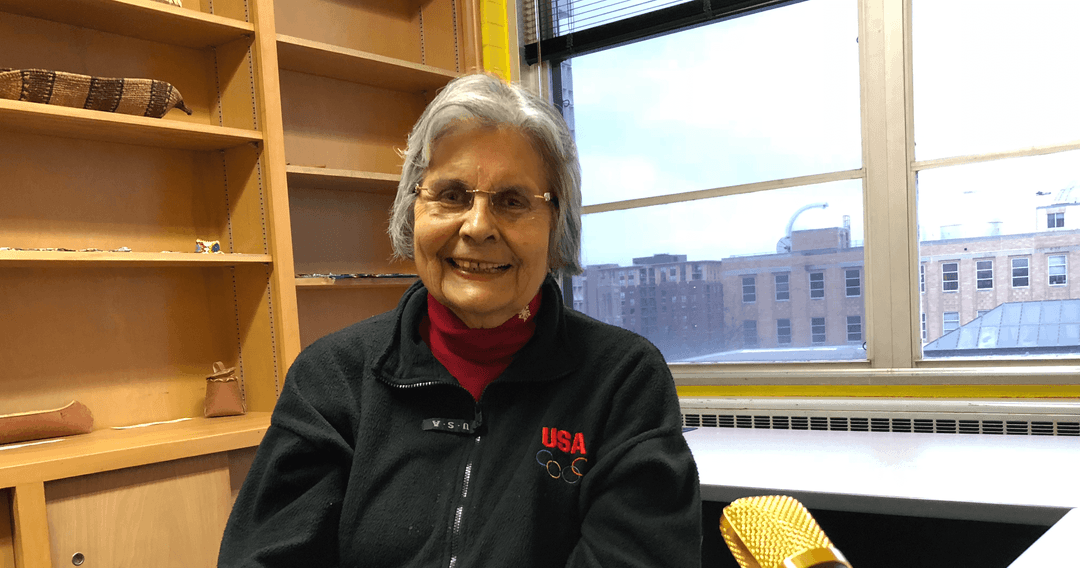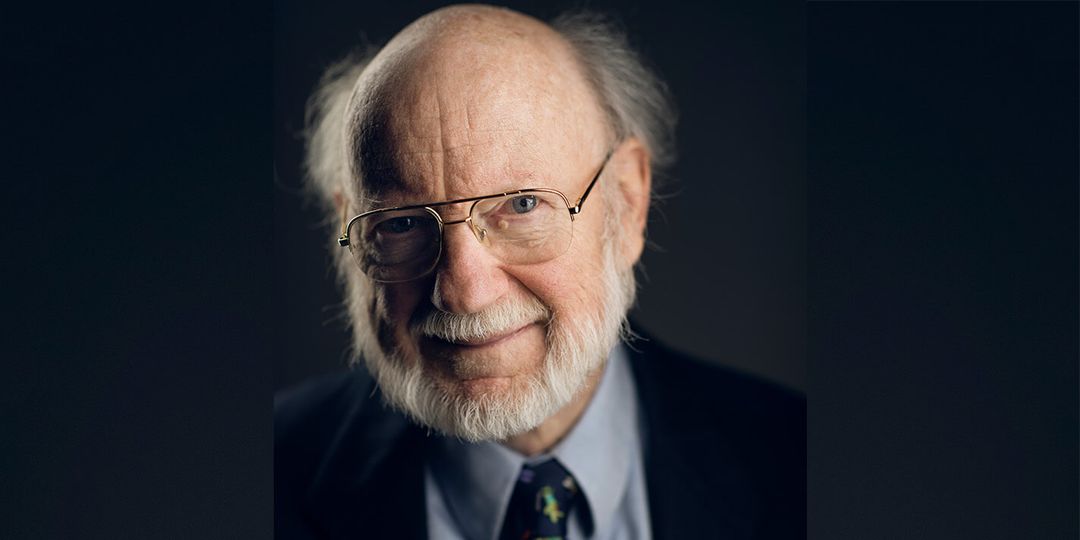Author and chemist Carl Djerassi passed away on Jan. 30, 2015. WAA mourns the passing of this accomplished alumnus.
2012 Distinguished Alumni Award Honoree

Carl Djerassi PhD’45 describes himself as an “intellectual polygamist.”
He is an art collector, playwright and author of at least 20 books and plays. But his first love was chemistry.
Djerassi (pronounced Jer-rassy) is best known as one of the inventors of the birth control pill, but he’s a true polymath, a gifted person who, like Leonardo Da Vinci, excels across multiple disciplines from science to humanities.
He made a fortune with scientific businesses, and in his 60s, he began to write novels and plays. He created fellowships for writers and dramatists. He started an artists’ community.
“By changing professions, I’m really in my middle 40s,” said the 88-year-old University of Wisconsin-Madison chemistry alumnus. “I started from scratch (in my 60s).”
Intellectual polygamy for Djerassi is not promiscuity or flitting from one shallow achievement to the next. He’s all in whatever he does. He just does it sequentially.
“Polygamy, serious polygamy, is where you have various marriages and each of them is important,” Djerassi told MoreIntelligentLife.com in 2009. “And in the ideal polygamy, I suspect there’s no No. 1 wife and no No. 6 wife. You have a deep connection with each person.”
Djerassi says that all of us need to think about how to create these new stages in our lives. If he can do it, presumably so can you, he contends.
The scientist-writer traveled this past spring to Europe, where he spends part of each year in London and Vienna. He also has a home in San Francisco, where he has lived since 1989. His schedule of presentations, speeches and awards extends into 2013 and across two continents.
The Way He Was Built
“I don’t act like a 90-year-old,” he says of his daily exercise regime and his busy schedule of talks and performances of his plays.
People half his age envy his energy and drive. For Djerassi, it’s just the way he was built.
He grew up in Vienna and Bulgaria, and fled Europe as a teen with his mother, a physician, to escape Nazi repression. With about $20 in their pockets, they arrived in the United States, only to be robbed by a taxi driver of their last dime. Djerassi’s mother joined a medical practice in upstate New York, and her son began his academic climb, graduating summa cum laude from Kenyon College. He arrived for graduate studies in Madison at 20 years old with a wife and a UW stipend that helped the couple live for two years while he completed his PhD in chemistry.
After graduation from college and before moving to Madison, he worked at the CIBA Pharmaceutical Company in New Jersey on a patent for the first commercial antihistamine, and after another four years at CIBA following his PhD from UW-Madison, he joined Syntex in Mexico City as associate director of chemical research. It was there that his research with Luis Miramontes and George Rosenkranz led to the development of the first successful oral contraceptive in the early 1950s.
Equally important to chemists is Djerassi’s work on the first synthesis of cortisone from a plant raw material as well as work on new anti-inflammatory agents.
Djerassi moved on to academic life in his late 20s at Wayne State University in Detroit from 1952 to 1959. William Johnson, a UW-Madison chemistry professor, had kept in touch with Djerassi, and in 1959, Johnson was offered the chairmanship of the chemistry department at Stanford University. He told Stanford he would not take the job unless Djerassi was also hired as professor. The bluff worked, and the two chemists went to California as a package, Djerassi says.
By this time, Djerassi was a wealthy man. He purchased a large parcel of land near Woodside, Calif., for a cattle ranch. At the same time, he began his next career as an art collector, focusing on the drawings and paintings of Paul Klee.
Djerassi became vice president of Syntex in Mexico City and later president of Syntex Research in Palo Alto, Calif. He helped found another company, Zoecon, which focused on pest control using hormonal strategies rather than insecticide — work for which he was awarded the National Medal of Technology from President George H.W. Bush.
Djerassi’s next move is inextricably tied to Diane Middlebrook, a well-known feminist teacher, poet, biographer and professor of literature at Stanford. The pair met in 1977 when Djerassi was in his mid-50s. He already had written books about science and the invention of the Pill. He began to write poetry, and his growing interest in writing fiction led him to publish his first novel, Cantor’s Dilemma, in 1989 at the age of 66.
“One way to teach science and talk about its culture is through fiction or drama,” Djerassi told WAA in 2003. “By using the cloak of fiction, I can illustrate and discuss ethical dilemmas that are frequently not raised for reasons of discretion, embarrassment, or fear of retribution.”
Djerassi calls the genre “science in fiction” and, when applied to drama, “science in theater.” His goal was to “smuggle science to the public under the cloak of fiction.” And while the two careers may seem disjointed, it was indeed Djerassi’s experience with the development of the Pill that pulled him into the politics of public policy and the brutal politics of academia.
In his personal life, his love affair with Middlebrook led to marriage in 1985, and they both retired from Stanford in 2002. The novel and memoir writing turned to plays. Meanwhile, Djerassi collected more honors on top of his many scientific awards, including 27 honorary doctorates, the National Medal of Science, the Perkin Medal, the National Medal of Technology, the first Wolf Prize in chemistry, and the Priestley Medal, which is the American Chemical Society’s highest award.
He is a member of the U.S. National Academy of Sciences, the American Academy of Arts and Sciences, the Royal Society (London) and many other foreign academies. An Austrian postage stamp was issued to honor him in 2005.
He and his fans still await one award, the Nobel Prize, which is the topic of an ethical dilemma in at least one book, and a dominant theme in Djerassi’s two-act play Oxygen, which he wrote with the Nobelist Roald Hoffmann.
Djerassi began to make larger contributions in the effort to preserve artistic freedom and excellence in the 1970s. When his daughter, an artist, committed suicide in 1978, Djerassi and Middlebrook converted his ranch in the Santa Cruz Mountains west of Stanford into the Djerassi Resident Artists Program in her memory. The community currently serves 90 artists each year in the fields of visual arts, literature, composition, and choreography. More than 2,000 artists have passed through the program since its foundation.
In 1997, Djerassi’s generosity benefited UW-Madison’s English department when he established two fellowships in creative writing, and again in 2007 with the Carl Djerassi Fellowship in Playwriting.
“No one I have ever met has so seamlessly combined the roles of scientist, historian, art collector, philosopher, musicologist, philanthropist, poet, novelist, memoirist, and playwright, as has Carl Djerassi,” says Ron Wallace, professor in the UW-Madison Department of English. “I’m really looking forward to hearing him read from his moving and revealing new book of poems, entitled A Diary of Pique, about his sometimes tempestuous relationship with the love of his life, Diane Middlebrook.”
Djerassi has also been associated with UW-Madison Professor Bassam Shakhashiri’s Initiative for Science Literacy. And in March 2011, Djerassi was a marquee guest for UW-Madison’s Year of the Arts, where he presented readings of two of his works and met with both arts and science students.
Middlebrook’s premature death from cancer in 2007 again gave Djerassi a moment to reassess his direction. His first play had been staged in 1998, and the University Theatre in Madison presented Oxygen in 2003. During his wife’s last days, which he refers to as the most traumatic time of his life, Djerassi wrote Four Jews on Parnassus, a posthumous conversation among four extraordinary intellectuals of the 20th century: philosopher Walter Benjamin, intellectuals Theodor W. Adorno and Gershom Scholem, and composer Arnold Schönberg. Djerassi recommends it as the first book for those interested in his work.
The much-lauded scientist and artist admits that his work is autobiographical, a frontier unavailable to scientists.
“We are not allowed to use dialogue in our work (as scientists), nor do we usually employ the first-person singular,” he says, adding that in his writing, “I talk in a hidden way about things that I could not talk about in an autobiography.”
In 2011, Djerassi wrote a new work called Foreplay, published by the UW Press in 2011 and described as risqué by some. The UW-Madison Department of Theatre and Drama performed a staged reading in 2011. His latest play, Insufficiency, skewers the tenure system and its effect on scientific discovery and will be presented in Madison on October 26 in the chemistry department, one month after its review in London.
Djerassi says he first fell in love with theater at UW-Madison in the 1940s when he saw Othello performed by Paul Robeson and Uta Hagen in the main roles, and he’s eager to see his work come to life in the place where his interest in drama was kindled.
His fondness for Madison and the UW has grown in recent years. He became an American citizen in Wisconsin during his graduate studies, and he salutes the “first-class education" he received there.
“I was really imprinted in Madison” as a European émigré, he says, adding that his physical presence on campus led to many of the literary efforts he is now pursuing.
On his next trip to Madison, he is eager to gather graduate students, who are starting on campus just as he did, to discuss Insufficiency and teach them more about “science in fiction” and “science in theater.”
In Appreciation
I spent only a bit over two years in Madison (1943–1945), but the shortness belies their importance. I had only arrived in the United States in December 1939 as a penniless refugee from Nazi Vienna, and after graduation from Kenyon College in 1942, I had to earn some money by working for a year as a research chemist at CIBA in New Jersey. But then I received a WARF fellowship for graduate work at UW-Madison. Somehow, this convinced my wife-to-be, who was four years older than I, to take my marriage proposal seriously. I spent my wedding night in a Pullman compartment in the train from Dayton, Ohio (where I got married) to Madison.
I thus arrived at the University of Wisconsin in 1943 as an ambitious but still budding scientist, who wanted to show his new wife that she had made a good choice. The WARF fellowship meant that I could work full-time without having to serve as a teaching assistant, thus getting my PhD in express time in 1945 just before my twenty-second birthday. This PhD did not just prove to be my union card for a career in science, but the collegiality of some of my fellow students and the care and training I received from various professors left an indelible imprint on me. In addition, Madison is where I became a naturalized American citizen in 1945.
Over 50 years later, I turned into a playwright, for whom attending the theatre has been a lifetime passion. Yet, even though I have seen hundreds of plays in my life, the most memorable performance undoubtedly occurred in Madison, when as a graduate student I had the privilege of seeing Paul Robeson as Othello, Uta Hagen as Desdemona, and José Ferrer as Iago in Shakespeare’s Othello. I would like to think that not only my chemical career, but subliminally, also my current one as a playwright started on the shores of Lake Mendota.








